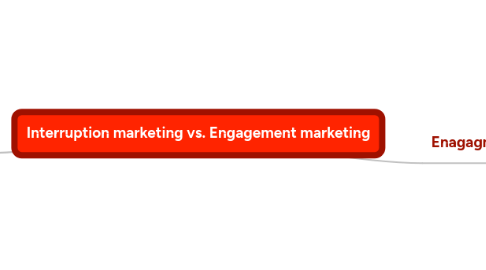
1. Interruption marketing
1.1. People
1.1.1. Linear thinking
1.1.2. Left-brain thinking
1.1.3. extrinsically motivated
1.2. Processes
1.2.1. Management driven
1.2.2. Efficiency focused
1.2.3. Driven by the question: How can we make money from our customers?
1.2.4. Algorithmic (routines with a set outcome)
1.2.5. Based on traditional economics
1.2.6. Disciplines and media as a starting point
1.2.7. Agency and location focussed
1.3. Keyconcepts/definition
1.3.1. 1. Create awareness 2. Awareness could lead to consideration 3. Consideration could lead to preference 4. Preference could lead to the ultimate goal: A purchuse
1.3.2. Interruption marketing is the process of finding a prospect engaged in something else, like reading a magazine, watching television, watching a game, driving to work and interrupting him/herwith a commercial message.
1.4. Goals
1.4.1. Influence/pursuade large groups of people to make a purchase: Generating/boosting sales
1.4.2. Informing large groups of people
1.4.3. Creating a brand
1.4.4. Creating or enlarging name recognition
1.5. pros ands cons
1.5.1. pros
1.5.1.1. Interruption marketing is quit good to measure
1.5.1.2. It is very scalable
1.5.1.3. It is could help companies with some quick wins
1.5.2. cons
1.5.2.1. People are seeeing to seeing many( a few thousand) ads a day causing 'ad blindness'
1.5.2.2. The effect of interruption marketing is rarely about the long-term and contributing to a sustainable brand
1.5.2.3. If quick wins are the goal, their is always a danger of damaging the brand
1.5.2.4. It is not a good tool for companies to distinguish themselves
1.5.2.5. Investment never decline because of the short-term effect. Repetition is key.
1.5.2.6. Defragmented media make it harder to reach many people and target the right people
1.6. Measurement
1.6.1. What?
1.6.1.1. GPRs (gross rating points) | Response rates | Cost per click
1.7. Character/tags
1.7.1. Passive
1.7.2. Sales driven
1.7.3. Quantity
1.7.4. Reach
1.7.5. Company centered
1.7.6. One-way communication
1.7.7. Quick wins
1.7.8. A few media
1.7.9. Business to consumer communication
1.7.10. Short-term focus
2. Enagagment marketing
2.1. Keyconcepts/definition
2.1.1. 1. Create influence 2. Influence leads to intimacy 3. Intimacy leads to involvement 4. Involvement leads to the ultimate goal: Interation
2.1.2. Engaging in a conversation with with peers, customers and staff, innovating with them and constantly improving your value proposition in an authentic way. Customers have the power, the information, the advice and the resources to make their own decisions, in the digital world its about joining the conversation. It's about transparency and allowing consumers to participate and shape your brand based on authentic interactions between your employees, product or service and your customers. It also turns the traditional marketing paradigm on its head -- using the interaction with one to spread "affect and influence" thru their personal network.
2.2. Proces
2.2.1. Design thinking/driven
2.2.2. Starting with ideas
2.2.3. Value driven
2.2.4. Human centered
2.2.5. Opportunistic thinking
2.2.6. Driven by the question: For what value(s) are customers truly willing to pay?
2.2.7. Based on behavioral economics
2.2.8. Heuristic (design of new outcomes and nonlinear)
2.2.9. Organic
2.3. People
2.3.1. Multidisciplinary
2.3.2. Networks
2.3.3. Right-brain thinking
2.3.4. intrinsicly motivated
2.4. Goals
2.4.1. Creating and maximizing brand loyalty. Maximizing sales per customer and creating better sales cycles.
2.4.2. Creating and maximizing brand advocacy (consumer to consumer communication)
2.4.3. Innovation trough better listening, feedback, co-creation and crowdsourcing (participation)
2.4.4. Building a sustainaible brand (Build on trust and authenticity)
2.5. pros ands cons
2.5.1. pros
2.5.1.1. Relationships are not only about better sales cycles but also about things like better participation to boost product and service innovation
2.5.1.2. Brand become more authentic and customers more loyal because there is more trust
2.5.1.3. It contributes to building sustainable brands
2.5.1.4. When more brand advocacy growing marketing cost can be lowered. There is more space for innovation.
2.5.2. cons
2.5.2.1. It's all about the long-term. Reach can only be earned by creating value, relevancy and trust.
2.5.2.2. Measuring methods are available but the tools are not sufficient yet
2.5.2.3. Scalability is not always as easy as with interruption marketing
2.6. Measurement
2.6.1. What?
2.6.1.1. Involvement — the presence of a person at the various brand touchpoints. Metrics include Web site visitors, time spent per page, physical store visits, impressions from mass media advertising, etc. Data sources include Web Analytics, store traffic reports, etc.
2.6.1.2. Interaction — the actions people take while present at those touchpoints. Metrics include click-throughs, online transactions, in-store purchases, uploaded photos or videos, etc. Data sources include eCommerce platforms, POS systems, social media platforms, etc.
2.6.1.3. Intimacy — the affection or aversion a person holds for a brand.Metrics include sentiment measurement in blog posts, blog comments, discussion forums, customer service call sentiment,etc. Data sources include brand monitoring services, survey responses, customer service call centers, etc.
2.6.1.4. Influence — the likelihood a person is to advocate on behalf of the brand. Metrics include brand awareness, loyalty, affinity, repurchases, Net Promoter, satisfaction ratings, forwarded content, etc. Data sources include market research services, brand monitoring, customer service call centers, surveys, etc.
2.7. Character/tags
2.7.1. Active
2.7.2. Interaction
2.7.3. Many defragmented media
2.7.4. Permission
2.7.5. Loyalty
2.7.6. Empathy
2.7.7. Intimicy
2.7.8. Who? not: how many?
2.7.9. Emotion and experiences
2.7.10. Trust
2.7.11. Consumer to consumer communication
2.7.12. Co-creation
2.7.13. Influence
2.7.14. Relevancy
2.7.15. Social
2.7.16. Long-term focus
2.7.17. Value
2.7.18. Content
2.7.19. Quality
2.7.20. Customer focussed
